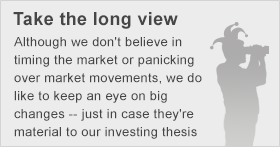
U.S. stocks opened flat on Thursday, and they closed flat, as well, exhibiting little volatility during the session, with the benchmark S&P 500 finishing the day down one-hundredth-of-a-percent. The narrower Dow Jones Industrial Average (^DJI 0.45%) fell 0.1%. Note that the CBOE Volatility Index (^VIX +5.00%) lost 1.2%, to close at 13.25, which is toward the bottom of its range for the year (and much below its historical average of 20.11). Perhaps traders are sitting on the sidelines, waiting for tomorrow's April employment report. The first estimate of first-quarter GDP growth came in at an underwhelming 0.1% yesterday, so traders and analysts will be looking for evidence that growth has accelerated since then.

Source: Wikimedia Commons
In company-specific news, professional networking platform LinkedIn (LNKD +0.00%) reported its results for the first quarter after today's close. In doing so, it joined another high-profile social-networking name, Twitter (TWTR +0.00%), in beating Wall Street's expectations for the first quarter, but disappointing with regard to its outlook. LinkedIn's shares are down in the after-hours session.
Here's a table that shows how LinkedIn's results and outlook relate to analysts' consensus estimates going into the report:
|
|
Actual |
Analysts' consensus estimate |
|---|---|---|
|
Q1 2014 Revenue |
$473.2 million BEAT |
$466.6 million |
|
Q1 2014 Earnings-per-share |
$0.38* BEAT |
$0.34 |
|
LinkedIn's outlook |
Analysts' consensus estimate | |
|
Q2 2014 Revenue |
$500 million-$505 million MISS |
$505.1 million |
|
2014 Revenue |
$2.06 billion-$2.08 billion MISS |
$2.11 billion |
*Adjusted EPS. Source: Thomson Financial Network, LinkedIn
If the after-hours price action in the stock is any indication (and it usually is when it comes to earnings announcements), the market is having a bit of a hissy fit with regard to the company's outlook for the current quarter and the full year 2014. However, let's put things in perspective: If LinkedIn hits the midpoint of both guidance ranges, it would represent 38% year-on-year revenue growth for the June quarter, and 35% for 2014. In an economy that is struggling to grow at 3% per year, that's still good enough to merit being called a growth company.
Of course, the issue for the stock market is not just whether LinkedIn can continue to grow fast relative to the broad economy or to some absolute benchmark, but how its growth ultimately compares to the growth expectations that are embedded in its stock price. At 53.3 times the forward earnings-per-share, those expectations are substantial, but not, in my opinion, insurmountable, as they appeared to be when the shares hit their all-time high of $257.56 last September.
LinkedIn's business model is the most durable of any of the major social networking firms. Unlike Twitter, for example, LinkedIn isn't suffering an identity crisis concerning the nature and scope of its service. All three of LinkedIn's segments are growing comfortably, with growth rates in the first quarter ranging from 36% to 50%, and their relative contribution to the business has remained stable compared to the year-ago period (Talent Solutions, which represents 58% of total revenue, grew at 50% year on year.)
Assessing LinkedIn against analysts' consensus estimates for the current quarter, or even the current year, isn't the right way to think about the company or the shares -- assuming you're an investor, not a trader. Investors would be better off trying to model a range of scenarios for what the company can achieve during the next three to five years. Under that framework, today's guidance "miss" becomes irrelevant and, within that time frame, LinkedIn could well deliver decent (though not necessarily spectacular) returns.






